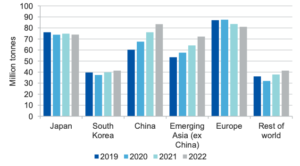China pledges its economy will be carbon neutral by 2060
Mining
Mining
Asia’s industrial powerhouse China has set an ambitious target of achieving net zero carbon dioxide emissions from its economy by the year 2060 with implications for Australian exports.
China’s president Xi Jinping made the pledge in a speech by videolink to the United Nation’s General Assembly in New York, Tuesday.
“We aim to have CO2 emissions peak before 2030 and achieve carbon neutrality before 2060,” President Xi said in his speech, the BBC reported.
The pledge has implications for Australia, which has lots of trade ties with China, and ships large amounts of commodities to the country, including carbon-based energy products such as gas and coal.
China is expected to import 67 million tonnes of coking coal in 2020 for use in steelmaking, increasing to 76 million tonnes in 2022.
Thermal coal imports for China’s electricity generation industry are expected to fall to 225 million tonnes in 2022, from 230 million tonnes this year, said Australia’s chief economist in a June quarter report.
Much of the coking coal China imports originates from Australia, as does some thermal coal imports, and some LNG deliveries.
Liquefied natural gas (LNG) shipments to China are forecast at 68 million tonnes in 2020, rising to 83 million tonnes by 2022, said the report. LNG emits less carbon dioxide gas than coal when burned for power generation.
EV demand in China is growing and could drive demand for battery metals such as nickel, copper and graphite mined in Australia.

Resources consultancy firm Wood Mackenzie said China’s carbon neutral announcement marks a significant shift in Beijing’s position toward assuming a leadership role in tackling climate change.
“The world’s largest, and growing, energy market, China currently contributes about 28 per cent of global [carbon dioxide] emissions,” said Woodmac research director, Alex Whitworth.
This is equivalent to around 10 billion tonnes of carbon, according to Woodmac.
But questions remain about the nature of China’s bold pledge on reducing its carbon emissions, said Woodmac Asia-Pacific vice-chairman Gavin Thompson.
“Firstly, China’s definition of ‘carbon neutrality’ is not well defined from the short announcement,” Thompson said.
“Further, no roadmap was offered as to how this will be achieved. 2060 is a long time out and immediate, concrete steps have yet to be announced,” he said.
Beijing’s next five-year economic plan begins in 2021, and is expected to contain more detail on China’s target of achieving a carbon neutral economy in 40 years’ time.
“Increased investment in wind, solar, electric vehicle and battery storage technology deployment will almost certainly feature, and we can expect support for green hydrogen and carbon capture technology,” said Thompson.
“But if any country can achieve such ambitious goals it will be China,” he said, adding that the country’s strong state coordination has been effective at reaching economic goals.
In its recently released Accelerated Energy Transition Scenario (AET-2) report, Wood Mackenzie has forecast that China’s carbon emissions will likely fall 60 per cent from current levels by 2040.
“The impact on global energy and commodity markets and seaborne trade is significant in our AET-2 scenario,” said Prakash Sharma, Woodmac’s head of markets and transitions.
“Major commodity exporters’ strategies are reset too to align with China’s ambitions,” he said.